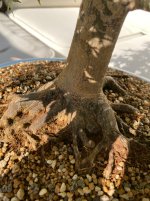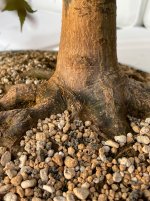Noulinator
Sapling
Hi everyone,
I really hope someone here can help me. I’m deeply worried about my Japanese maple ‘Deshojo’, which is showing signs of what I suspect might be root rot, fungal or bacterial infection — and I fear it could be dying.
Recently, I noticed that the nebari has turned darker and slightly blackened, and some dark patches have started appearing on the trunk as well. I honestly don’t know if those marks were there before, or if I’ve only started noticing them now because of the nebari’s change in colour.
All the leaves on the tree look completely healthy — no wilting, no spotting, and no signs of distress when viewed from above. The issue seems to be limited to the trunk, bark, and nebari.
It’s worth mentioning that there was a recent storm with very strong winds, and it seems like the symptoms may have started shortly after that. In general, the weather has been cold, damp, and windy for quite a while, but now it’s becoming warmer and sunnier.
I’ve been fertilising with BioGold organic fertiliser, and until now the tree seemed fine. As soon as I noticed something was off, I removed all moss from the surface and also removed any remaining fertiliser. I replaced the top layer of soil with fresh substrate to increase airflow around the surface roots.
So far, I haven’t done more than that. I’ve also bought 3% hydrogen peroxide, but haven’t used it yet.
Right now, I’m unsure what to do next and would really appreciate some advice:
This tree means a lot to me — it’s my favourite — and I’m very upset about the situation. Any advice, even small suggestions, would be really appreciated.
Thank you so much in advance.
I really hope someone here can help me. I’m deeply worried about my Japanese maple ‘Deshojo’, which is showing signs of what I suspect might be root rot, fungal or bacterial infection — and I fear it could be dying.
Recently, I noticed that the nebari has turned darker and slightly blackened, and some dark patches have started appearing on the trunk as well. I honestly don’t know if those marks were there before, or if I’ve only started noticing them now because of the nebari’s change in colour.
All the leaves on the tree look completely healthy — no wilting, no spotting, and no signs of distress when viewed from above. The issue seems to be limited to the trunk, bark, and nebari.
It’s worth mentioning that there was a recent storm with very strong winds, and it seems like the symptoms may have started shortly after that. In general, the weather has been cold, damp, and windy for quite a while, but now it’s becoming warmer and sunnier.
I’ve been fertilising with BioGold organic fertiliser, and until now the tree seemed fine. As soon as I noticed something was off, I removed all moss from the surface and also removed any remaining fertiliser. I replaced the top layer of soil with fresh substrate to increase airflow around the surface roots.
So far, I haven’t done more than that. I’ve also bought 3% hydrogen peroxide, but haven’t used it yet.
Right now, I’m unsure what to do next and would really appreciate some advice:
- Should I take the tree out of the pot and inspect the roots for rot, and remove anything unhealthy?
- Or should I leave the roots alone and instead water with diluted hydrogen peroxide to address any pathogens in the soil?
- Can I also apply the peroxide to darkened or suspicious areas of the nebari and trunk?
This tree means a lot to me — it’s my favourite — and I’m very upset about the situation. Any advice, even small suggestions, would be really appreciated.
Thank you so much in advance.
Attachments
-
 IMG_8525.jpeg462.4 KB · Views: 102
IMG_8525.jpeg462.4 KB · Views: 102 -
 IMG_8526.jpeg460.9 KB · Views: 86
IMG_8526.jpeg460.9 KB · Views: 86 -
 IMG_8527.jpeg432.8 KB · Views: 77
IMG_8527.jpeg432.8 KB · Views: 77 -
 IMG_8523.jpeg423.4 KB · Views: 71
IMG_8523.jpeg423.4 KB · Views: 71 -
 IMG_8524.jpeg408 KB · Views: 71
IMG_8524.jpeg408 KB · Views: 71 -
 IMG_8528.jpeg464 KB · Views: 71
IMG_8528.jpeg464 KB · Views: 71 -
 IMG_8529.jpeg570.2 KB · Views: 72
IMG_8529.jpeg570.2 KB · Views: 72 -
 IMG_8532.jpeg537.7 KB · Views: 64
IMG_8532.jpeg537.7 KB · Views: 64 -
 IMG_8533.jpeg431.3 KB · Views: 52
IMG_8533.jpeg431.3 KB · Views: 52 -
 IMG_8531.jpeg470.4 KB · Views: 53
IMG_8531.jpeg470.4 KB · Views: 53 -
 IMG_8530.jpeg422 KB · Views: 85
IMG_8530.jpeg422 KB · Views: 85











